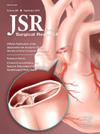农村国家可预防的摄入异物转移
IF 1.7
3区 医学
Q2 SURGERY
引用次数: 0
摘要
摄入异物的儿科患者的不必要转移给患者和家庭带来了重大的社会和经济负担。我们试图评估在农村地区摄入异物后与潜在可避免的设施间转移相关的患者因素。材料和方法这是一项多地点回顾性队列研究,包括患者;在2022年1月5日至2024年4月30日期间,因摄入异物转至三级儿科医院进行手术评估的18例。可预防转移(PVT)被定义为任何在转移前成像中有胃食管交界处以下物体的患者,不需要手术干预或接受任何额外的异物处理服务。结果纳入171例患者,其中26.3% (n = 45)确定为pvt。在pvt和不可预防转移之间没有发现人口统计学变量的差异。对象类型在可预防组中最常见的是“其他”,在不可预防转移组中最常见的是硬币[60%对71%,P <;0.001]。74.3% (n = 126)的转院患者和近一半(46.7%,n = 21)的pvt被要求进行外科会诊,尽管97.8%的pvt最终从急诊科出院。结论超过四分之一的患者因摄入异物而转移到医院是可以预防的。这些发现表明,医院间转诊指南的标准化或远程医疗会诊的实施有机会减少过度分类,提高与这一常见儿科主诉相关的医疗保健利用效率。本文章由计算机程序翻译,如有差异,请以英文原文为准。
Preventable Transfers of Ingested Foreign Bodies in a Rural State
Introduction
Unnecessary transfer of pediatric patients with ingested foreign bodies presents significant social and financial burdens for patients and families. We sought to assess patient factors associated with potentially avoidable interfacility transfers after foreign body ingestion in a rural state.
Materials and methods
This is a multisite retrospective cohort study including patients < 18 y who were transferred to a tertiary pediatric hospital for surgical evaluation due to ingested foreign body between January 5, 2022, and April 30, 2024. Preventable transfer (PVT) was defined as any patient with an object below the gastroesophageal junction on pretransfer imaging not requiring surgical intervention or admission to any service for additional management of foreign body. Bivariate analysis and multivariable logistic regression were performed to evaluate for associations between patient factors and PVT.
Results
One hundred and seventy-one patients were included, with 26.3% (n = 45) identified as PVTs. No differences in demographic variables were seen between PVTs and nonpreventable transfers. Type of object was most commonly “other” in the preventable group and coin in the nonpreventable transfer group [60% versus 71%, P < 0.001]. Surgical consults were ordered for 74.3% (n = 126) of all transferred patients and almost half (46.7%, n = 21) of PVTs, despite 97.8% of PVTs being ultimately discharged from the emergency department.
Conclusions
Interfacility transfers of patients with ingested foreign bodies were characterized as preventable in over one-quarter of patients. These findings suggest an opportunity for interfacility transfer guideline standardization or implementation of telemedicine consultation to decrease overtriage and improve efficiency of health care utilization associated with this common pediatric chief complaint.
求助全文
通过发布文献求助,成功后即可免费获取论文全文。
去求助
来源期刊
CiteScore
3.90
自引率
4.50%
发文量
627
审稿时长
138 days
期刊介绍:
The Journal of Surgical Research: Clinical and Laboratory Investigation publishes original articles concerned with clinical and laboratory investigations relevant to surgical practice and teaching. The journal emphasizes reports of clinical investigations or fundamental research bearing directly on surgical management that will be of general interest to a broad range of surgeons and surgical researchers. The articles presented need not have been the products of surgeons or of surgical laboratories.
The Journal of Surgical Research also features review articles and special articles relating to educational, research, or social issues of interest to the academic surgical community.

 求助内容:
求助内容: 应助结果提醒方式:
应助结果提醒方式:


